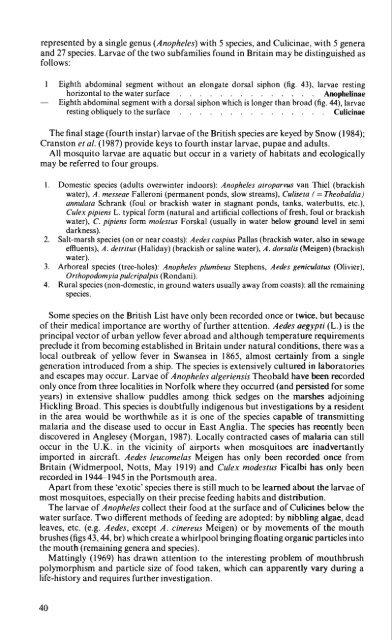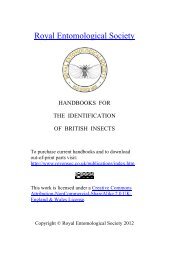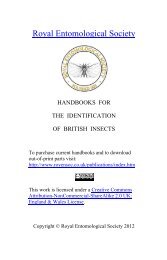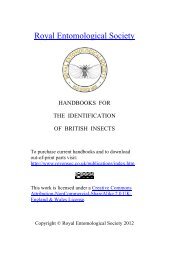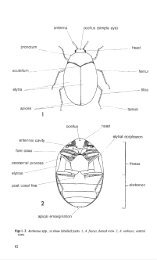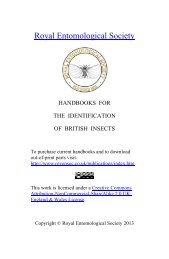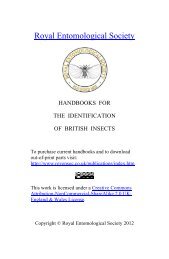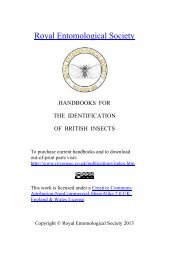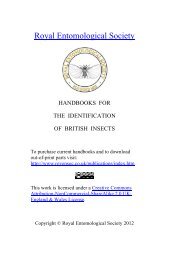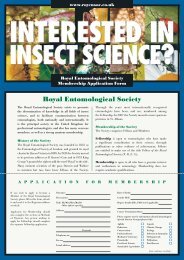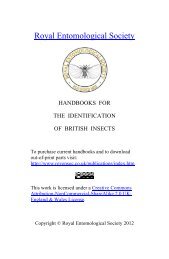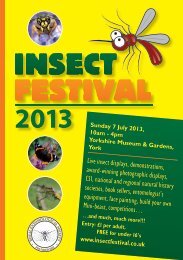Vol 10 Part 14. An introduction to the immature stages of British Flies ...
Vol 10 Part 14. An introduction to the immature stages of British Flies ...
Vol 10 Part 14. An introduction to the immature stages of British Flies ...
Create successful ePaper yourself
Turn your PDF publications into a flip-book with our unique Google optimized e-Paper software.
epresented by a single genus (<strong>An</strong>opheles) with 5 species, and Culicinae, with 5 genera<br />
and 27 species. Larvae <strong>of</strong> <strong>the</strong> two subfamilies found in Britain may be distinguished as<br />
follows:<br />
Eighth abdominal segment without an elongate dorsal siphon (fig. 43), larvae resting<br />
horizontal <strong>to</strong> <strong>the</strong> water surface . . . . . . . . . . . . . . <strong>An</strong>ophelinae<br />
Eighth abdominal segment with a dorsal siphon which is longer than broad (fig. 44), larvae<br />
resting obliquely <strong>to</strong> <strong>the</strong> surface . . . . . . . . . . . . . . . Culicinae<br />
The final stage (fourth ins tar) larvae <strong>of</strong> <strong>the</strong> <strong>British</strong> species are keyed by Snow ( 1984);<br />
Crans<strong>to</strong>n et al. ( 1987) provide keys <strong>to</strong> fourth ins tar larvae, pupae and adults.<br />
All mosqui<strong>to</strong> larvae are aquatic but occur in a variety <strong>of</strong> habitats and ecologically<br />
may be referred <strong>to</strong> four groups.<br />
I. Domestic species (adults overwinter indoors): <strong>An</strong>opheles atroparvus van Thiel (brackish<br />
water), A. messeae Falleroni (permanent ponds, slow streams), Culiseta ( = Theobaldia)<br />
annulata Schrank (foul or brackish water in stagnant ponds, tanks. waterbutts, etc.),<br />
Culex pipiens L. typical form (natural and artificial collections <strong>of</strong> fresh, foul or brackish<br />
water), C. pipiens form molestus Forskal (usually in water below ground level in semi<br />
darkness).<br />
2. Salt-marsh species (on or near coasts): Aedes caspius Pallas (brackish water, also in sewage<br />
effluents), A . detritus (Haliday) (brackish or saline water), A. dorsalis (Meigen) (brackish<br />
water).<br />
3. Arboreal species (tree-holes): <strong>An</strong>opheles plumbeus Stephens, Aedes geniculatus (Oiivier),<br />
Orthopodomyia pulcripalpis (Rondani).<br />
4. Rural species (non-domestic, in ground waters usually away from coasts): all <strong>the</strong> remaining<br />
species.<br />
Some species on <strong>the</strong> <strong>British</strong> List have only been recorded once or twice, but because<br />
<strong>of</strong> <strong>the</strong>ir medical importance are worthy <strong>of</strong> fur<strong>the</strong>r attention. Aedes aegypti (L.) is <strong>the</strong><br />
principal vec<strong>to</strong>r <strong>of</strong> urban yellow fever abroad and although temperature requirements<br />
preclude it from becoming established in Britain under natural conditions, <strong>the</strong>re was a<br />
local outbreak <strong>of</strong> yellow fever in Swansea in 1865, almost certainly from a single<br />
generation introduced from a ship. The species is extensively cultured in labora<strong>to</strong>ries<br />
and escapes may occur. Larvae <strong>of</strong> <strong>An</strong>opheles algeriensis Theobald have been recorded<br />
only once from three localities in Norfolk where <strong>the</strong>y occurred (and persisted for some<br />
years) in extensive shallow puddles among thick sedges on <strong>the</strong> marshes adjoining<br />
Hickling Broad. This species is doubtfully indigenous but investigations by a resident<br />
in <strong>the</strong> area would be worthwhile as it is one <strong>of</strong> <strong>the</strong> species capable <strong>of</strong> transmitting<br />
malaria and <strong>the</strong> disease used <strong>to</strong> occur in East <strong>An</strong>glia. The species has recently been<br />
discovered in <strong>An</strong>glesey (Morgan, 1987). Locally contracted cases <strong>of</strong> malaria can still<br />
occur in <strong>the</strong> U.K. in <strong>the</strong> vicinity <strong>of</strong> airports when mosqui<strong>to</strong>es are inadvertantly<br />
imported in aircraft. Aedes leucomelas Meigen has only been recorded once from<br />
Britain (Widmerpool, Notts, May 1919) and Culex modestus Ficalbi has only been<br />
recorded in 1944-1945 in <strong>the</strong> Portsmouth area.<br />
Apart from <strong>the</strong>se 'exotic' species <strong>the</strong>re is still much <strong>to</strong> be learned about <strong>the</strong> larvae <strong>of</strong><br />
most mosqui<strong>to</strong>es, especially on <strong>the</strong>ir precise feeding habits and distribution.<br />
The larvae <strong>of</strong> <strong>An</strong>opheles collect <strong>the</strong>ir food at <strong>the</strong> surface and <strong>of</strong> Culicines below <strong>the</strong><br />
water surface. Two different methods <strong>of</strong> feeding are adopted: by nibbling algae, dead<br />
leaves, etc. (e.g. Aedes, except A. cinereus Meigen) or by movements <strong>of</strong> <strong>the</strong> mouth<br />
brushes (figs 43, 44, br) which create a whirlpool bringing floating organic particles in<strong>to</strong><br />
<strong>the</strong> mouth (remaining genera and species).<br />
Mattingly (1969) has drawn attention <strong>to</strong> <strong>the</strong> interesting problem <strong>of</strong> mouthbrush<br />
polymorphism and particle size <strong>of</strong> food taken, which can apparently vary during a<br />
life-his<strong>to</strong>ry and requires fur<strong>the</strong>r investigation.<br />
40


